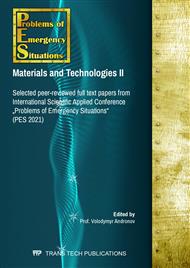p.177
p.185
p.193
p.203
p.210
p.221
p.235
p.242
p.251
Influence of ANO3 and ANO3·nH2O Nitrates on the Deformation Properties of Aluminosilicate Adhesives for Wood Products and Structures
Abstract:
As a result of the research, the deformation properties of aluminosilicate adhesives modified with nitrate salts and intended for gluing wooden products and structures made of pine, beech and oak wood at different stages of their hardening were determined. Considering that pine is the most common wood in the manufacture of products and structures, then in order to reduce the numerical values of the elastic modulus in glued materials, it is advisable to add ammonium, lithium and sodium nitrates in an amount of 0.5%, potassium nitrate in an amount of 1% into the composition of an aluminosilicate adhesive. which will ensure the approximation of the elastic modulus values to the values of the unmodified aluminosilicate adhesive and will significantly affect the water resistance of the glue joint and the depth of penetration of the adhesive into the wood structure. For gluing beech wood products to reduce the elasticity modulus, it is advisable to introduce 0.5% ammonium and potassium nitrates and 1% lithium and sodium nitrates, which will reduce the numerical values of the elastic modulus in glued materials by 1.18 and 1.53 times compared with the values of the elastic modulus of the unmodified aluminosilicate adhesive. For gluing oak wood products to reduce the elasticity modulus, it is advisable to introduce 0.5% potassium nitrate and 1.5% sodium nitrate, which will reduce the numerical values of the elastic modulus in glued materials by 1.4 and 2.83 times compared to the values modulus of elasticity of unmodified aluminosilicate adhesive.
Info:
Periodical:
Pages:
210-220
Citation:
Online since:
July 2021
Price:
Сopyright:
© 2021 Trans Tech Publications Ltd. All Rights Reserved
Share:
Citation:


